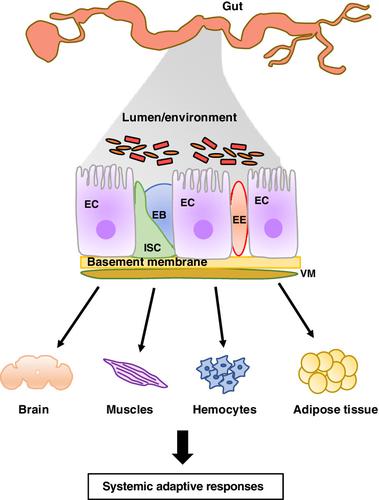当前位置:
X-MOL 学术
›
WIREs Mech. Dis.
›
论文详情
Our official English website, www.x-mol.net, welcomes your feedback! (Note: you will need to create a separate account there.)
The Drosophila gut: A gatekeeper and coordinator of organism fitness and physiology
WIREs Mechanisms of Disease ( IF 3.1 ) Pub Date : 2020-03-16 , DOI: 10.1002/wdev.378 Julien Colombani 1, 2 , Ditte S Andersen 1, 2
WIREs Mechanisms of Disease ( IF 3.1 ) Pub Date : 2020-03-16 , DOI: 10.1002/wdev.378 Julien Colombani 1, 2 , Ditte S Andersen 1, 2
Affiliation

|
Multicellular organisms have evolved organs and tissues with highly specialized tasks. For instance, nutrients are assimilated by the gut, sensed, processed, stored, and released by adipose tissues and liver to provide energy consumed by peripheral organ activities. The function of each organ is modified by local clues and systemic signals derived from other organs to ensure a coordinated response accommodating the physiological needs of the organism. The intestine, which represents one of the largest interfaces between the internal and external environment, plays a key role in sensing and relaying environmental inputs such as nutrients and microbial derivatives to other organs to produce systemic responses. In turn, gut physiology and immunity are regulated by multiple signals emanating from other organs including the brain and the adipose tissues. In this review, we highlight physiological processes where the gut serves as a key organ in coupling systemic signals or environmental cues with organism growth, metabolism, immune activity, aging, or behavior. Robust strategies involving intraorgan and interorgan signaling pathways have evolved to preserve gut size in homeostatic conditions and restrict growth during damage‐induced regenerative phases. Here we review some of the mechanisms that maintain gut size homeostasis and point out known examples of homeostasis‐breaking events that promote gut plasticity to accommodate changes in the external or internal environment.
中文翻译:

果蝇肠道:生物体适应性和生理学的看门人和协调者
多细胞生物进化出具有高度专业化任务的器官和组织。例如,营养物质被肠道同化,被脂肪组织和肝脏感知、加工、储存和释放,以提供外周器官活动消耗的能量。每个器官的功能都受到来自其他器官的局部线索和系统信号的影响,以确保协调反应适应生物体的生理需求。肠道是内部和外部环境之间最大的界面之一,在感知环境输入(如营养物质和微生物衍生物)并将其传递到其他器官以产生全身反应方面发挥着关键作用。反过来,肠道生理和免疫受其他器官(包括大脑和脂肪组织)发出的多种信号的调节。在这篇综述中,我们强调了生理过程,其中肠道作为将系统信号或环境线索与生物体生长、代谢、免疫活动、衰老或行为耦合的关键器官。涉及器官内和器官间信号通路的稳健策略已经演变为在稳态条件下保持肠道大小并在损伤诱导的再生阶段限制生长。在这里,我们回顾了一些维持肠道大小稳态的机制,并指出了促进肠道可塑性以适应外部或内部环境变化的稳态破坏事件的已知例子。我们强调了生理过程,其中肠道是将系统信号或环境线索与生物体生长、代谢、免疫活动、衰老或行为相结合的关键器官。涉及器官内和器官间信号通路的稳健策略已经演变为在稳态条件下保持肠道大小并在损伤诱导的再生阶段限制生长。在这里,我们回顾了一些维持肠道大小稳态的机制,并指出了促进肠道可塑性以适应外部或内部环境变化的稳态破坏事件的已知例子。我们强调了生理过程,其中肠道是将系统信号或环境线索与生物体生长、代谢、免疫活动、衰老或行为相结合的关键器官。涉及器官内和器官间信号通路的稳健策略已经演变为在稳态条件下保持肠道大小并在损伤诱导的再生阶段限制生长。在这里,我们回顾了一些维持肠道大小稳态的机制,并指出了促进肠道可塑性以适应外部或内部环境变化的稳态破坏事件的已知例子。涉及器官内和器官间信号通路的稳健策略已经演变为在稳态条件下保持肠道大小并在损伤诱导的再生阶段限制生长。在这里,我们回顾了一些维持肠道大小稳态的机制,并指出了促进肠道可塑性以适应外部或内部环境变化的稳态破坏事件的已知例子。涉及器官内和器官间信号通路的稳健策略已经演变为在稳态条件下保持肠道大小并在损伤诱导的再生阶段限制生长。在这里,我们回顾了一些维持肠道大小稳态的机制,并指出了促进肠道可塑性以适应外部或内部环境变化的稳态破坏事件的已知例子。
更新日期:2020-03-16
中文翻译:

果蝇肠道:生物体适应性和生理学的看门人和协调者
多细胞生物进化出具有高度专业化任务的器官和组织。例如,营养物质被肠道同化,被脂肪组织和肝脏感知、加工、储存和释放,以提供外周器官活动消耗的能量。每个器官的功能都受到来自其他器官的局部线索和系统信号的影响,以确保协调反应适应生物体的生理需求。肠道是内部和外部环境之间最大的界面之一,在感知环境输入(如营养物质和微生物衍生物)并将其传递到其他器官以产生全身反应方面发挥着关键作用。反过来,肠道生理和免疫受其他器官(包括大脑和脂肪组织)发出的多种信号的调节。在这篇综述中,我们强调了生理过程,其中肠道作为将系统信号或环境线索与生物体生长、代谢、免疫活动、衰老或行为耦合的关键器官。涉及器官内和器官间信号通路的稳健策略已经演变为在稳态条件下保持肠道大小并在损伤诱导的再生阶段限制生长。在这里,我们回顾了一些维持肠道大小稳态的机制,并指出了促进肠道可塑性以适应外部或内部环境变化的稳态破坏事件的已知例子。我们强调了生理过程,其中肠道是将系统信号或环境线索与生物体生长、代谢、免疫活动、衰老或行为相结合的关键器官。涉及器官内和器官间信号通路的稳健策略已经演变为在稳态条件下保持肠道大小并在损伤诱导的再生阶段限制生长。在这里,我们回顾了一些维持肠道大小稳态的机制,并指出了促进肠道可塑性以适应外部或内部环境变化的稳态破坏事件的已知例子。我们强调了生理过程,其中肠道是将系统信号或环境线索与生物体生长、代谢、免疫活动、衰老或行为相结合的关键器官。涉及器官内和器官间信号通路的稳健策略已经演变为在稳态条件下保持肠道大小并在损伤诱导的再生阶段限制生长。在这里,我们回顾了一些维持肠道大小稳态的机制,并指出了促进肠道可塑性以适应外部或内部环境变化的稳态破坏事件的已知例子。涉及器官内和器官间信号通路的稳健策略已经演变为在稳态条件下保持肠道大小并在损伤诱导的再生阶段限制生长。在这里,我们回顾了一些维持肠道大小稳态的机制,并指出了促进肠道可塑性以适应外部或内部环境变化的稳态破坏事件的已知例子。涉及器官内和器官间信号通路的稳健策略已经演变为在稳态条件下保持肠道大小并在损伤诱导的再生阶段限制生长。在这里,我们回顾了一些维持肠道大小稳态的机制,并指出了促进肠道可塑性以适应外部或内部环境变化的稳态破坏事件的已知例子。


























 京公网安备 11010802027423号
京公网安备 11010802027423号